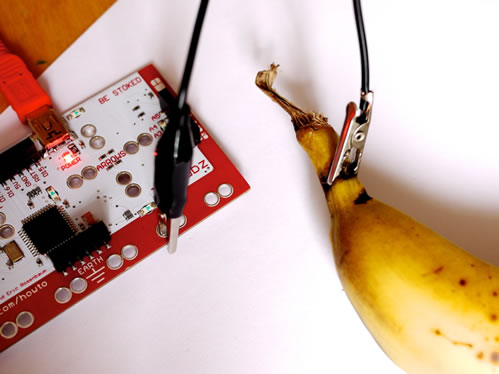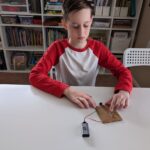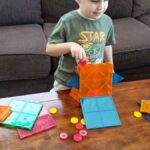Makey Makey is an invention kit aimed at getting kids to use their imagination and be an inventor!
It’s gaining popularity just because of how much you can do with a single kit.
All you need to get started is the Makey Makey board, alligator clips, a USB cable, and your imagination. The Makey Makey kit comes with everything you need!
To get you started we have compiled some of our favorite Makey Makey games and projects for both the home or in the classroom. If you’re still on the fence about if you should buy a Makey Makey, read this guide!
We’ll walk you through your top questions – What is a Makey Makey? And what can you do with a Makey Makey?
Or, jump below to see our roundup of Makey Makey project ideas.
Table of Contents
What is a Makey Makey?
A Makey Makey is an invention kit. It consists of a simple circuit board, alligator clips, and a USB cable. The circuit board allows you to turn everyday objects into your mouse or keyboard by using closed-loop electrical signals.
Plug your Makey Makey into your computer using the USB cable. Then use the alligator clips to connect the Makey Makey to conductive objects you want to turn into your keyboard!
By connecting bananas or playdough to your Makey Makey you can play a game with bananas or playdough!
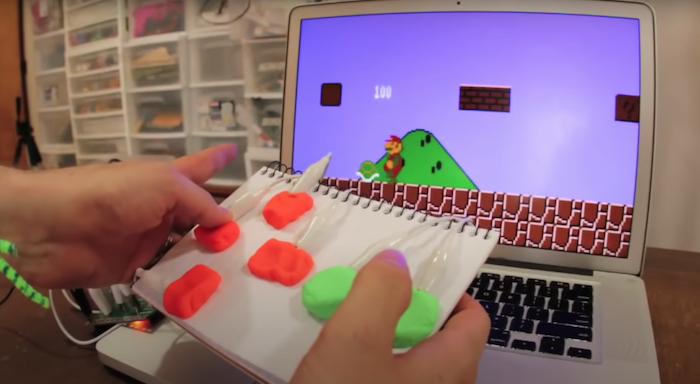
What can you do with a Makey Makey?
The sky is the limit when it comes to Makey Makey!
It can be connected to virtually anything, as long as it can conduct a little bit of electricity; you can connect bananas and play the piano or connect alphabet soup and type a message.
Even better, if you have already incorporated Scratch or Arduino into the classroom Makey Makey can work alongside those too for more advanced coding & hardware lessons.
You can approach using Makey Makey like a science lab. When using Makey Makey half of the fun is in the planning stage. You can make the projects as large or small as you want. Some projects can be modified to take up an entire room (like using stairs as a piano), others can be done on a small table.
First, have students brainstorm and come up with ideas on how they can tackle the project. Then have them mock up an example of the circuit and game. Finally, have them implement their ideas, test them and troubleshoot where necessary, and improve the designs as they go.
Here are some Makey Makey ideas to get the creative juices flowing!
8 Makey Projects & Games to Get You Started
Here’s a few of our favorite projects to get started with a Makey Makey. Also, be sure to check out their website and Instructables page which has an abundance of resources & lesson plans for teachers.
1. The Simple Circuit
For those students who are just learning the ins and outs of electric circuits, you can start with a simple circuit project. Have the students make a simple circuit using an LED plugged into the Makey Makey board so they know when they have successfully completed the circuit.
You can add to this by creating challenges for the students.
See if they can complete a circuit with people incorporated into the loop, or create a piano keyboard by using foil wrapped popsicle sticks (you will need a separate application for this). You can add complexity by challenging the students to include parallel circuits too. There really is no limit to this simple project!
2. Play the piano
This is likely the activity (followed by a viral video) that put the Makey Makey on the map!
To add some music to your lesson you can use the simple piano key application found on Makey Makey’s website here.
Just plug in the Makey Makey with the USB cable and connect the key terminals available on the back of the Makey Makey board to essentially anything using a length of wire and alligator clips.
You can play with lots of different foods (marshmallows, macaroni and cheese, shrimp), clays such as Play-Doh, foil, or objects wrapped in foil (popsicle sticks work great for this).
To get a more complex piano keyboard you can create your own (or have your students experiment with coding) by using Soundplant, Scratch, or other similar programs. Again, you can make this project as complex as you want to cater to the ability and imagination of your students.
3. Magnetic Mazes
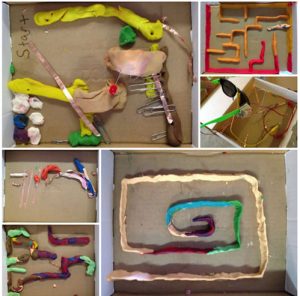
For a project that requires a little more know how you can have the students create a Makey Makey maze.
Have the students sketch out the maze and determine the flow of electricity. The Play-Doh (or other conductive clay material) serves as the walls, and the students navigate the maze using magnets.
The object is to make it through the maze without touching the magnet to the wall, if they do then the light goes on and they start over. This project can last several days as the students alter and reinvent their mazes as they refine their ideas- exactly what engineers do! They can even form groups and challenge other groups to see who can complete their maze the fastest.
4. Whack a mole (or potato!)
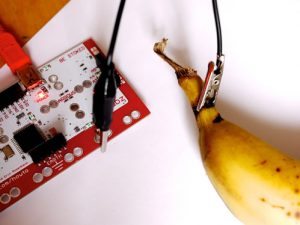
Bring this timeless arcade game into the classroom.
This project is as simple as you want it to be, there is software freely available so you can just download, connect, and play.
Or, the code can also be altered to add complexity and customize the game for your students to make it even more enticing. You connect the ‘holes’ that you will be whacking to anything that conducts electricity (bananas probably won’t hold up too well so potatoes are a better choice for this).
As the mole comes up the student attempts to hit it by hitting the potato or other object that you have hooked up. By altering the code, you can change essentially every aspect of the game- even add pictures of the students as the ‘moles’ to make it more fun.
5. Presentation Pizazz
Have the students add a little showmanship into their presentation by using Makey Makey to go to the next slide in their Powerpoint.
You can let the students freely experiment with conductive materials in order to make their presentations more interactive.
They can use conductive thread or other materials that turn them into wearable devices that connect to the Makey Makey and hit the right arrow key when it’s time for their next slide. They can use things like cardboard bracelets wrapped in foil or gloves with conductive thread woven into them to complete the circuit and move on to the next slide. The possibilities are endless!
No matter how you choose to incorporate Makey Makey into your lessons it will surely open their eyes to the magic of electricity and expand their imagination. The games and activities are so fun that students won’t even know that their learning.
6. Play a Drumset
Turn whatever you want into a drumset! Fruit makes a great creative set. Use Makey Makey’s bongo app and start playing.
7. Build Your Own Dance Dance Revolution Game
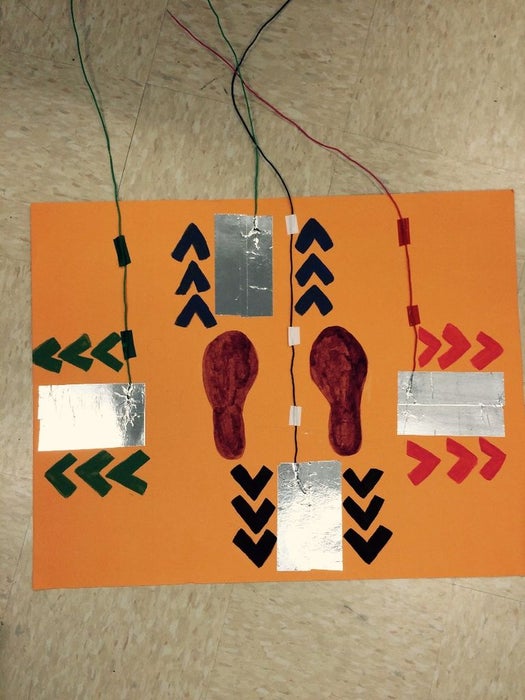
Using buckets of water or foil and posterboard, create your own dance floor! This is a fun activity to get kids moving, while learning.
Makey Makey was among the top 10 toys & games we reviewed for the 10 best STEM toys. See the rest!
Want to know more?
This video is awesome… it will definitely want to make you order a Makey Makey now!

